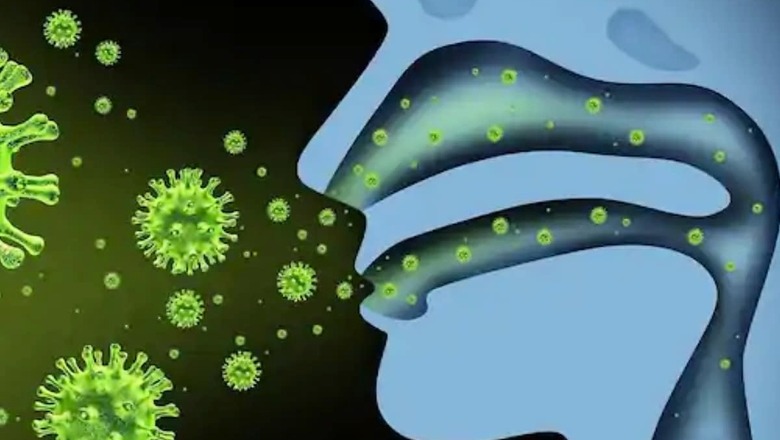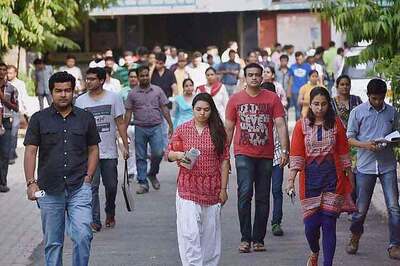
views
When the double mutant strain of Covid-19 was found in California, American scientist William A Haseltine wrote in Forbes, “The B.1.617 variant has all the hallmarks of a very dangerous virus. If indeed it is this variant that is driving the unprecedented exponential increase in infections in India, the potential for trouble here in the United States is real and immediate. We must do all that is possible to identify its spread and to contain it.”
Maharashtra, that carries half of the active caseload burden in India, suspects the mutant is behind the second wave surge in the state and has sent samples to the union health ministry to confirm it. Kerala, where the novel coronavirus was first detected in India, has asked its health department to find out if the variant is behind the disease transmission in the state.
But India has downplayed the impact of the possible risk associated with this coronavirus variant, saying the number of such mutations is still very small and cannot be generalised as the main reason behind the Covid surge in the country. The Centre also added that more studies were needed before reaching a conclusion.
While speaking to CNN-News18, Dr Rakesh K Mishra, director of CSIR-Centre for Cellular and Molecular Biology, Hyderabad, a premier research organisation of the Government of India in frontier areas of modern biology, further corroborated the stand taken by the Centre. “Double mutant is not the main reason behind the Covid surge in India. The variant is found in just about 10% of the cases in the country which have been genome sequenced at present. What about then 90% of the cases where double mutant is not the factor? Even in Maharashtra, the double mutant is found in about 30% of the cases only,” he said. “Yes, it is increasing its footprint day by day but it is just one component.”
According to him, the main factor responsible for the second wave surge is the public’s attitude as people are mostly not following Covid-appropriate behaviour like wearing masks or maintaining social distance.
The World Health Organization (WHO) also sees the mutant as a ‘variant of interest’ and not as ‘variant of concern’.
On the other hand, scientists and virologists say the variant may be behind the rise but they need adequate data before reaching any conclusion. “It seems to be the case but we cannot say it scientifically. We cannot say so as we have sequenced very small numbers of samples, some 15,000 so far, and we so do not have adequate data to conclude that the B.1.617 variant is responsible for the surge,” said Dr Vineeta Bal, an immunologist and a visiting professor at the Indian Institute of Science Education and Research (IISER), Pune.
Double mutant, or B.1.617 lineage
Evolution of different genomic variants of viruses or mutants is a natural phenomenon. These mutations make them stronger or weaker. They evolve or mutate more rapidly when there is a greater and wider surge in infections, something that is now the case in India where cases are increasing exponentially and it indicates we might be facing a stronger coronavirus variant if indeed the B.1.617 variant is behind this surge.
The B.1.617 coronavirus variant was identified for the first time in India on October 5, 2020. It was later identified in November and December as well. Two coronavirus escape mutants, E484Q and L452R, found in other coronavirus variants as well, came together to form a third strain in the spike protein part that a virus uses to infect human cells.
B.1.617 can enhance viral replication. The variant is far more transmissible than the original one as its spike proteins have more binding power to attack and infect human cells. Dr Vineeta Bal added, “Based on preliminary data it appears that one mutation in this variant may make it more infectious so it can be behind the rapid disease transmission.”
And the lineage is evolving rapidly, with now even a third mutation being found in the samples collected from Maharashtra, Delhi, West Bengal and Chhattisgarh. Can this third mutation make it more virulent? “We don’t know that yet. We cannot say if the third mutation may raise the virulence even more. We need to go through the testing process that may take around 3 to 4 weeks,” said Dr Bal.
But CCMB director Dr Mishra said we should not be worried about another mutation in the B.1.617 variant, adding that we should not use misnomers like double or triple mutant. “We don’t need to be worried about the B.1.617 variant or another mutation happening to it. In fact, we should not use terms like double or triple mutants. They are misnomers and rather we should use the term lineage,” he said. “As said above, B.1.617 has been found in just 10% of the samples sequenced so far while nothing much is known about its triple mutant version.”
Can the B.1.617 variant be more fatal?
While Dr Mishra said we should not be worried about the B.1.617 lineage, Dr Bal argued that the variant may cause more death figures even if it does not appear to cause more serious disease. “In itself, the variant does not appear to cause more serious disease. However, a very rapid increase in the number of patients is leading to crumbling of infrastructure and that may lead to an increase in the death rate,” she said. “It also seems there is serious underreporting of death figures with many deaths going unreported.”
Can the B.1.617 variant derail the vaccine programme?
E484Q and L452R are escape mutations, meaning they can evade a person’s immune system. If the double mutant also possesses the immune escape mechanism, theoretically, it may escape the antibodies in the human body developed from vaccination or previous infection.
But it should not derail our vaccine programme, said Dr Bal. “It is not likely to derail the vaccination progress and we need to see that it does not. Vaccinating yourself always puts you in an advantageous position against an infection whether caused by the original virus or caused by the double mutant here,” she said.
Spread of the B.1.617 lineage
The lineage has so far been detected in 10 states in India, including Maharashtra, Delhi, West Bengal, Gujarat, Karnataka, Madhya Pradesh and Jharkhand, as well as in 16 other countries.
According to outbreak.info that uses the global coronavirus genomic repository database GISAID as its source, till April 21, a total of 298 genomic sequences had been detected in India, 161 in the UK and 61 in the US.
Internationally, it has been found in countries like Australia, Belgium, Germany, Ireland, Namibia, New Zealand, Singapore, the UK and the US.
The Vidarbha region mystery
In India, as the genomic sequencing reports indicate so far, the lineage has largely been found in the state of Maharashtra. Between January and March this year, Maharashtra saw an increase of 15-20% in coronavirus double mutant count. On April 10, the National Institute of Virology shared a report of a limited genome sequencing analysis of positive samples which said the double mutant coronavirus was responsible for 61% of cases in Maharashtra. As many as 220 of 361 samples turned positive for the double mutant coronavirus.
The variant was detected in samples taken from Amravati, Akola, Thane, Aurangabad, Mumbai, Jalna, Palghar, Nanded, Bhandara, Hingoli, Gondia, Chandrapur, Nagpur, Pune, Wardha and Yavatmal districts. Amravati and Akola were the hardest hit districts. B.1.617 was found in 85% test samples of Akola district and was found in 69% test samples of Amravati district in the Vidarbha region of the state.
Why such a high concentration in Vidarbha region districts while the same has not been reflected in positive samples tested from other districts so far?
Dr Bal said, “We cannot say it was more concentrated in the Vidarbha region. We do not have information on how many samples from which district were analysed so we cannot reach a conclusion here. The double mutant has been found in other Maharashtra districts as well.”
What B.1.617 genome sequence numbers indicate
With mutant coronavirus strains being detected in many people coming from abroad, on December 25, India said it was going to establish the Indian SARS-CoV-2 Consortium on Genomics (INSACOG) to find new mutants or variants of concern (VoC) of Covid-19.
The consortium was launched on December 30. INSACOG is a network of 10 Regional Genome Sequencing Laboratories (RGSLs) and includes ICMR-NIV Pune, CSIR-CCMB Hyderabad, CDFD Hyderabad, CSIR-IGIB Delhi, NCDC Delhi, InStem/NCBS Bengaluru, NIMHANS Bengaluru, NIBMG Kalyani and ILS Bhubaneswar.
While launching INSACOG, the central government promised to analyse 5% positive test samples from each state and 100% positive test samples from international travellers for genome sequencing. Yet, by March 30, 2021, INSACOG could analyse just 11,000 samples, or a tenth of the 5% target assured to the states.
A report in The Indian Express, quoting a scientist working on the mandate given, said the consortium programme has no clear directives and goals.
In 100 days from December 30 to April 9, based on an update from a health ministry’s source information, INSACOG could genome sequence only around 14,000 test samples for coronavirus variants.
This might look troublesome when we see that these are the variant strains that are driving Covid cases globally. The UK variant is behind 40% Covid cases in Asia followed by the South African variant that is behind 16% cases as per an analysis by Newstrain, a pathogen tracking project. In the United Kingdom, the UK variant causes 98% of the new cases while in the US,the same variant is the reason behind 25-30% cases.
What B.1.617 genome sequence numbers indicate
India and many other countries provide genome sequencing data to GISAID and it shows how laggard India has been here. As per the GISAID database, the UK has, so far, provided 3.75 lakh genomes, followed by the US with 3.02 lakh genomes, Germany with around 63,000 genomes and Denmark with over 50,000 genomes. But India, the second hardest-hit nation, could just share 8,392 genome sequences so far.
And 70% of those sequences contain B.1.617, said Prof Sharon Peacock, director of COG-UK, and professor of public health and microbiology, University of Cambridge. But he also added that this is a very small number compared to the overall infection scale in India.
Many states and health officials are now demanding that more focus should be on identifying VoCs like the B.1.617. They demand that genome sequencing analysis of more test samples should now be done on a bigger scale and results should be given as soon as possible.
“We should sequence more,” said Dr Mishra. “We have a target of 5% and the system is now in place and we are sure to sequence more in the coming days.” But he also counted the factors that can slow the required workflow, “like if someone turns Covid positive then it affects the work. Like people working in the sequencing team are also involved in sequencing samples related to exponential rise in the cases, checking if re-infection or infection after vaccination has any link to any variant or people dying or facing critical health problems after infection have any link to a variant, in addition to samples from airport, etc.”
But this slow pace owes more to the absence of infrastructure facilities and manpower, said Dr Bal. “We cannot expect the infrastructure required for genome sequencing, in addition to many other aspects of infrastructure to come up in India in just one year when the public healthcare system was largely neglected in the country,” she said. “It requires huge investment. Also we do not have enough manpower and we face hurdles in every step, whether it is collecting an adequate number of samples, identifying and labelling them, or transporting rapidly before actual sequencing can be done.”
This is something that Dr Mishra echoed. “Sending samples for genome sequencing for variant surveillance purposes needs to cover most if not all geographical locations, which is a big logistical challenge: collecting samples from small areas in different districts and then sending them to designated labs with proper cold chain involves huge challenges at every step,” he said.
INSACOG also faced funding problems, even if genome sequencing is an expensive and time-taking process.
Sequencing a single genome may take 4 days and Rs 5,000: Dr Mishra said the average cost of genome sequencing a sample is between Rs 4,000 to 5,000 but it can further vary based on the situation – number of samples processed in a go, technology platform used, etc. According to him, the fastest time to genome sequence a sample is two days. On an average, it takes 3 to 4 days.
Are INSACOG labs funded for it? The government allotted Rs 115 crore for them to be used over six months but the money never came. Later on, it directed the department of biotechnology to release Rs 80 crore from its own resources in March. Meanwhile, RGSLs diverted some of their internal funds to meet consortium mandates, and so, on the ground, they finally failed to realise the high promises the government made.
Dr Mishra says the government has adequately funded the sequencing programme by releasing Rs 80 crore that is to be used over four months.
Read all the Latest News, Breaking News and Coronavirus News here. Follow us on Facebook, Twitter and Telegram.




















Comments
0 comment